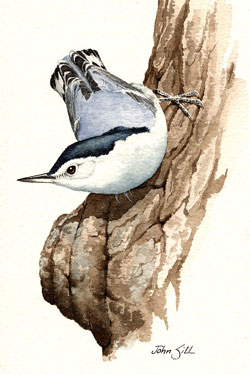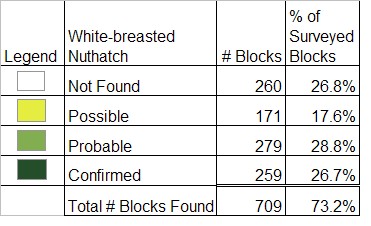Breeding Bird Atlases (BBA)
Find a Bird - BBA1
Breeding Bird Atlas 1 Species Accounts
White-breasted Nuthatch
Sitta carolinensis
Egg Dates
April 3 to May 25
Number of Broods
one; may re-lay if first attempt fails.

One of our commoner woodland birds, the White-breasted Nuthatch is notable for its jerky, zigzag movements as it hitches itself up and down tree trunks in search of insects, regularly descending a tree headfirst. It is a species of mixed woodland, village trees, and orchards and is basically a permanent resident, breeding throughout the state, more sparingly on Cape Cod but absent from Nantucket.
White-breasted Nuthatches have a rather nasal ank-ank-ank call note. The number of notes in a sequence is an indication of the individual’s state of excitement, with a double note and finally a rapid series of notes given during increasing agitation. Such excitement is often due to territorial conflict and may be accompanied by fanning of the tail and ruffling of the back feathers. As the pair, or the family, forages through the territory, the birds often keep contact with a soft ip or it note. In addition, the male has a simple song of six to eight wee-wee-wee or wer-wer-wer-wer notes.
Nuthatch pairs maintain a relationship throughout the year, inhabiting a territory of 25 to 50 acres. Pair bonds last for several seasons, perhaps for life. Courtship may begin during the winter or in early spring. The male repeatedly sings the wer-wer-wer song, bows to the female, and brings her items of food.
The nest is usually between 10 and 50 feet from the ground in a natural tree cavity, old woodpecker hole, or birdhouse. Five Massachusetts nests were discovered in nest boxes in suburban woods and 1 in an elm cavity 18 feet from the ground (CNR). The birds may use bluebird boxes. The cavity opening must be at least 1.5 inches in diameter, but they prefer one that is somewhat larger. Both sexes gather bark, grasses, rootlets, and fur for the nest. One Massachusetts nest was constructed of loose bark and a few small stones and was lined with soft feathers and fur (CNR). Near the opening the birds engage in a peculiar behavior called “bill-sweeping” (Stokes 1983), often with an insect held in the beak. The purpose of this is not clear.
Five to ten (average eight) eggs are laid. Each is short, oval in shape, and white with the larger end capped with light brown to lavender spots. Clutch sizes for 6 Massachusetts nests were six eggs (1 nest), seven eggs (2 nests), eight eggs (2 nests), and nine eggs (1 nest) (CNR, DKW). There is one brood a year, and for 12 days the female does most, if not all, of the incubation. Both parents feed the young in the nest for 14 days, and for about two weeks after they fledge. Nestlings have been recorded in Massachusetts from May 13 to June 20 (CNR). Adults feeding from one to eight still-dependent young have been reported from June 4 to July 4 (BOEM, CNR, Meservey).
In late summer, the young have a partial molt, and the adults undergo their annual molt. Although family groups may remain together through November, changes occur in the social behavior, and the young begin to disperse. Although individual nuthatches roost in separate holes throughout the year, in autumn the members of a pair become increasingly independent in their foraging as well. They spend more of their time gathering nuts and seeds and storing them in cracks and crevices. Food is often wedged in such places to hold it so the birds can hatchet it open with their bills. From this habit, the family name is derived.
Most of our White-breasted Nuthatches are year-round residents, although some individuals, probably mostly immature birds, wander widely in winter. These birds can pair with a territorial bird if the mate is lost. At times, some migrant nuthatches arrive from farther north. In winter, White-breasted Nuthatches tend to roam the woods in small mixed-species groups that include chickadees, woodpeckers, and perhaps a Brown Creeper or two.
Map Legend and Data Summary
Atlas 1 data collected from 1975-1979


Note: fairly common in deciduous woodlands; scarcer in southeastern coastal areas and absent on Nantucket
Charles E. Roth



